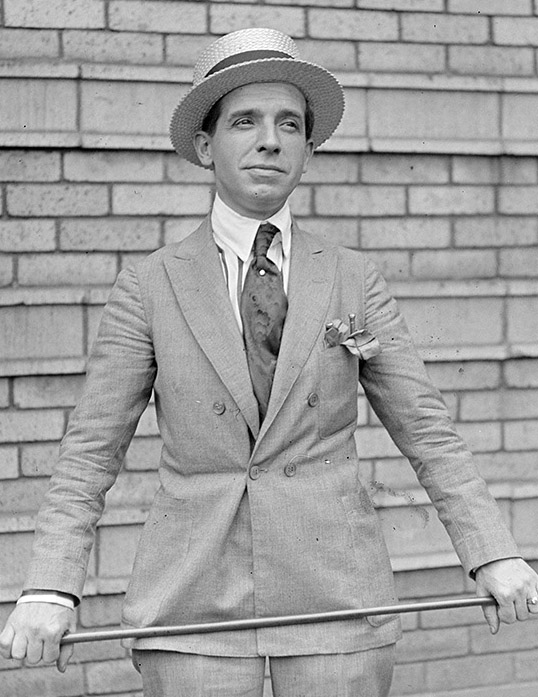Stocks Are Not a Ponzi Scheme and Here’s Why Not
When you mail a letter to someone in another country, you can enclose an international reply coupon (IRC) that can be exchanged for that country’s postage stamps and used to mail a letter back to you. It is like enclosing a self-addressed stamped envelope except that you do not need to figure out how to buy foreign postage stamps. It is the polite thing to do but also the source of the most famous swindle in history.

In 1920, a Massachusetts man named Charles Ponzi (right, in 1920) promised to pay investors 50 percent interest every 45 days. Compounded eight times a year, the effective annual rate of return was 2,463 percent! He said that his profits would come from taking advantage of the difference between the official and open market prices of Spanish pesos. He would buy Spanish pesos cheap in the open market, use these pesos to buy international reply coupons, and then trade these coupons for U. S. postage stamps at the higher official exchange rate. If everything worked as planned, he could buy 10 cents worth of U. S. postage stamps for a penny. (It was not clear how he would convert these stamps into cash; would he open his own post office?) In practice, he received $15 million from investors and appears to have bought only $61 in stamps.
If he didn’t invest any money, how could he afford to pay a 50 percent return every 45 days? He couldn’t. But he could create a temporary illusion of doing so. Suppose that a person invests $100, which Ponzi spends on himself. If Ponzi now finds two people to invest $100 apiece, he can give the first person $150, and keep $50 for himself. Now, he has 45 days to find four people willing to invest $100, so that he can pay each of the two previous investors $150 and spend $100 on himself. These four can be paid with the money from eight new investors, and these eight from sixteen more.
Ponzi’s legacy is the label, Ponzi scheme. In a Ponzi scheme, money from new investors is paid to earlier ones, and it works as long as there are enough new investors. The problem is that the pool of fish is exhausted surprisingly soon. The 21st round requires a million new people and the 30th round requires a billion more. At some point, the scheme runs out of new people and those in the last round (the majority of the investors) are left with nothing. A Ponzi scheme merely transfers wealth from late entrants to early entrants (and to the person running the scam).
Ponzi’s scam collapsed after eight months when a Boston newspaper discovered that during the time that he supposedly bought $15 million in postage coupons, the total amount sold worldwide came to only $1 million. Ponzi was soon in jail on charges of larceny and mail fraud.
I recently read an article by Tim Denning, a writer for CNBC and Business Insider with the provocative title, “The Stock Market Is a Ponzi Scheme.” It was inspired by “financial expert Tan Lui,” who argues that,
The simple truth is profits from buying and selling stocks come from other investors who are buying and selling stocks. When someone buys low and sells high, another sucker is also buying high and needs to sell for even higher. Companies like Google, Amazon, and Tesla never pay their shareholders. Their investors profits are dependent on the inflow of money from new investors, which by definition, is how a Ponzi scheme works.
Tim Denning, “The Stock Market Is a Ponzi Scheme” at Medium
Therefore, Liu concludes that, “$34 trillion of stock value = $0 in real money.” The irony here is that stocks are generally the antithesis of a Ponzi scheme. The defining characteristic of Ponzi schemes is that the promoter does not buy profitable assets, so the only way to pay investors anything is with the money received from new investors. Stocks in profitable companies, in contrast, generate cash that is available to give investors, though companies may choose to retain some or all of that cash to continue making profitable investments on behalf of their shareholders.
Liu had been a bike courier and freelance photojournalist before he began working in finance. Suppose that he had started a small bike courier business, Liu Delivers, and was married at the time, with his spouse working in finance and paying all their living expenses. Suppose, too, that Liu Delivers is reliably profitable, but Liu doesn’t take any money out of the business. Instead, he pays off the money he borrowed to get started, advertises, hires more couriers, puts in a modern billing system, stockpiles cash, and increases his profits by double-digit amounts year after year. Is Liu Delivers a Ponzi scheme because it doesn’t pay dividends? Hardly. Liu Delivers is valuable because it generates a substantial cash flow, unlike a Ponzi scheme that merely shuffles cash from new investors to old investors.
What if Liu had a partner? Would that make Liu Delivers a Ponzi scheme? What if he had a million partners? It is not the number of owners that makes something a Ponzi scheme. Liu Delivers would still be a valuable company and Liu and his partners would still be happy that they were part owners. Liu Delivers might pay dividends or make share repurchases at some point, perhaps when further expansion is not warranted. Or Liu Delivers might be sold to another company, but that hardly matters. The intrinsic value of Liu Delivers comes from the company’s profitability, not from the size of its dividend or the number of owners.
Consider, too, Berkshire Hathaway. Berkshire doesn’t pay dividends so, by Liu’s criterion, it is a Ponzi scheme. Yet, Berkshire owns lots of companies that do pay dividends. For example, Berkshire owns 250 million shares of Apple stock, which is currently valued at nearly $100 billion and pays Berkshire $800 million in annual dividends. How can Apple stock be real money that is turned into a Ponzi scheme when it purchased by Berkshire? It makes no sense, because Liu’s argument is nonsensical.
Finally, consider this example of how a stock could be a Ponzi scheme. Suppose that Liu Delivers had been an accounting scam. The company didn’t actually make money but, even so, reported robust, rapidly growing profits every quarter. These fraudulent reports might allow Liu Delivers to issue more stock every year, using the proceeds to pay dividends to its shareholders. Liu Delivers pays regular dividends but is nonetheless a Ponzi scheme. It is not the absence or presence of dividends that determine whether a stock is or is not a Ponzi scheme. It is the absence or presence of real profits.
Fortunately, the overwhelming majority of U.S. corporations run real, profitable businesses. Unlike Ponzi schemes, they have been and will continue to be worth investing in.
You may also enjoy: Inflation Is the least of our worries! Yet some fear that the inflation dragon is about to roar. The Federal Reserve (the Fed) can throw the economy into recession whenever it feels an unruly inflation needs to be tamed by the discipline of unemployment. (Gary Smith)
